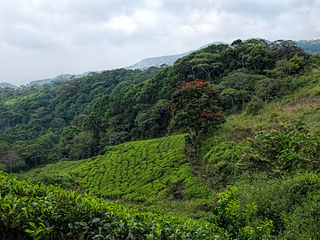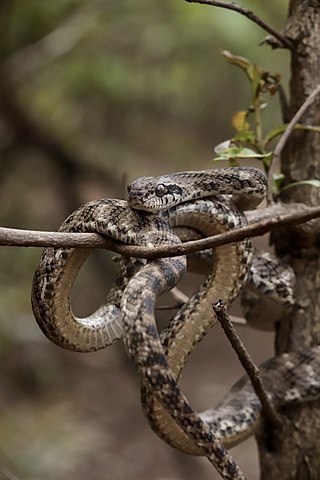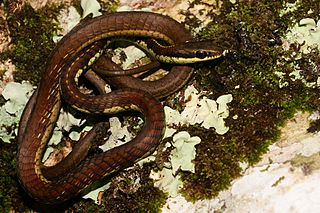
Sinharaja Forest Reserve is a forest reserve and a biodiversity hotspot in Sri Lanka. It is of international significance and has been designated a Biosphere Reserve and World Heritage Site by UNESCO.

Ahaetulla nasuta, also known as Sri Lankan green vine snake and long-nosed whip snake, is a venomous, slender green tree snake endemic to Sri Lanka.

Boiga ceylonensis is a species of rear-fanged, mildly venomous, nocturnal, arboreal colubrid snake endemic to Sri Lanka.

Boiga forsteni, also known as Forsten's cat snake, is a species of mildly venomous rear-fanged colubrid endemic to South Asia.

Dendrelaphis bifrenalis, also called Boulenger's bronzeback, Boulenger's bronze-back, and Travancore bronze-brown snake, is a colubrid snake native to Eastern Ghats of Southern India and Sri Lanka. It was first described by George Albert Boulenger in 1890. Dendrelaphis wickrorum from Sri Lanka was previously confused with this species.

Rhabdophis plumbicolor, known as the green keelback or lead keelback, is a species of nonvenomous snake in the family Colubridae native to parts of the Indian subcontinent.

Ahaetulla, commonly referred to as Asian vine snakes or Asian whip snakes, is a genus of colubrid snakes distributed throughout tropical Asia. They are considered by some scientists to be mildly venomous and are what is commonly termed as 'rear-fanged' or more appropriately, opisthoglyphous, meaning their enlarged teeth or fangs, intended to aid in venom delivery, are located in the back of the upper jaw, instead of in the front as they are in vipers or cobras. As colubrids, Ahaetulla do not possess a true venom gland or a sophisticated venom delivery system. The Duvernoy's gland of this genus, homologous to the venom gland of true venomous snakes, produces a secretion which, though not well studied, is considered not to be medically significant to humans.

Dendrelaphis is a genus of colubrid snakes, distributed from Pakistan, India and southern China to Indonesia, Timor-Leste, the Philippines, Australia, New Guinea and the Solomon Islands. There are over forty described species. Asian species are known commonly as bronzebacks, while the Australo-Papuan species are simply called treesnakes. All are non-venomous and entirely harmless to humans.

Dendrelaphis punctulatus, also known commonly as the Australian tree snake, the common tree snake, and the green tree snake, is a species of slender, large-eyed, diurnal, non-venomous snake in the family Colubridae. The species is native to many parts of Australia, especially in the northern and eastern coastal areas, and to Papua New Guinea.

Boiga barnesii is a species of cat snake endemic to Sri Lanka. It is known as Barnes' cat snake in English and panduru mapila-පදුරු මාපිලා in Sinhala. It is a member of the snake family Colubridae. It is distributed in the lowlands and midlands up to approximately 600 m (2,000 ft) above sea level, with known localities include Matale, Kandy, Gannoruwa, Gampola, Ambagamuwa, Balangoda, Labugama and Sinharaja Rain Forest. Barnes' cat snake is mainly a forest-dwelling species but may occasionally be found in human habitats. It is the smallest cat snake in Sri Lanka and grows up to a maximum of about 600 mm (24 in) in snout-vent length. Being a nocturnal and an arboreal hunter, it mainly feeds on agamid lizards and geckos. The day time is usually spent inside a tree hole or a crevice. It’s a very timid and a mildly venomous snake and rarely attempts to bite.

Dendrelaphis schokari, also known as the common bronze-back or Schokar's bronzeback, is a species of non-venomous arboreal snake in the family Colubridae. The species is endemic to Sri Lanka.

Chrysopelea taprobanica, the Sri Lankan flying snake or Indian flying snake, is a species of gliding snake distributed in India and Sri Lanka. It can glide, as with all species of its genus Chrysopelea, by stretching the body into a flattened strip using its ribs. The snake is known as "dangara dandaa - දඟරදන්ඩා" in Sinhala, due to its folding postures.
Oligodon calamarius, commonly known as the reed-like kukri or Templeton's kukri snake, is a species of nonvenomous colubrid endemic to Sri Lanka. It is known as කබර දත්-කැටියා in Sinhala.
Dendrelaphis oliveri, commonly known as Oliver's bronzeback, is a species of nonvenomous arboreal snake in the family Colubridae. The species is endemic to Sri Lanka. It is considered to be the rarest of the Sri Lankan Dendrelaphis species on account of there being only a single recorded specimen.

Dendrelaphis nigroserratus is a species of snakes belonging to the bronzebacks (Dendrelaphis). It is found only in western and southwestern Thailand and the adjacent southeastern Myanmar. A specimen has been preserved in the British Natural History Museum, London since the early 20th century. Due to its resemblance to Wall's bronzeback, the scientific name was formerly assigned under Dendrelaphis cyanochloris, the species name for Wall's bronzeback. It was formally described as a distinct species in 2012 by Gernot Vogel, Johan Van Rooijen and Sjon Hauser. According to the World Wide Fund for Nature report, it became one of the 367 important new species discovered in the Greater Mekong during 2012 and 2013.
Oligodon annulifer, also known as the ringed kukri snake, is a colubrid snake endemic to the island of Borneo.

The Ahaetuliinae are a subfamily of the snake family Colubridae that was erected in 2016 and comprises five genera containing 63 species that are more closely related to one another than to members of the subfamily Colubrinae. Previously placed within Colubrinae, Ahaetuliinae was strongly supported as the sister group to Colubrinae in a 2016 study by Figueroa et al.
Dendrelaphis wickrorum, commonly known as Wickramasinghes' bronze-back, is a species of arboreal snake endemic to Sri Lanka.

Boiga whitakeri, or Whitaker's cat snake, is a species of nocturnal, arboreal, opisthoglyphous snake of the family Colubridae. It is endemic to the Western Ghats of South India, in Kerala and Tamil Nadu states.












